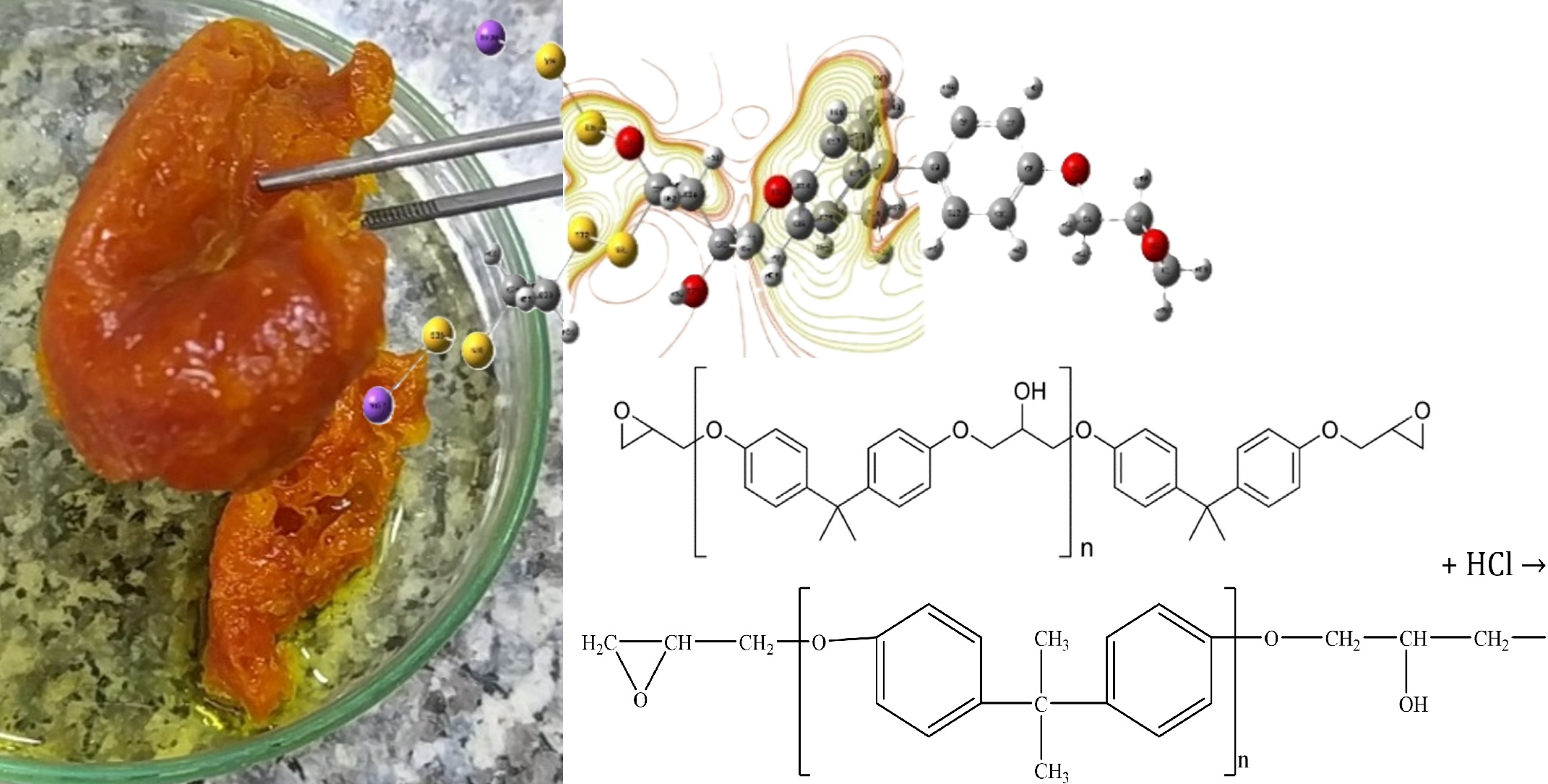SYNTHESIS OF OLIGOMER BASED ON SODIUM POLYSULFIDE AND HYDROLYZED ED-20 EPOXY RESIN: STRUCTURE AND PROPERTIES
DOI:
https://doi.org/10.15421/jchemtech.v33i3.328434Keywords:
Oligomer synthesis, 1,1,2-trichloroethane, hydrolyzed ED-20 epoxy resin, sodium polysulfide, reaction kinetics, physicochemical propertiesAbstract
This article studies the process of oligomer synthesis based on sodium polysulfide, hydrolyzed ED-20 epoxy resin and 1,1,2-trichloroethane. The reaction mechanism, synthesis conditions and physicochemical properties of the product are analyzed. Based on the results of scientific research, the dependence of the oligomer formation process on temperature, reaction time, and reagent concentration was determined. UV-spectral analysis of the obtained sodium polysulfide oligomer (UV-Vis spectrometer range 350–800 nm, maximum reflectance – 67.02 %, light absorption – 323 nm), IR spectra, elemental analysis were conducted. The electron density surface (ESP) of the synthesized oligomer based on sodium polysulfide, hydrolyzed ED-20, and 1,1,2-trichloroethane optimized at the B3LYP/6-31G(d) level is presented in the GAUSSIAN 16 program. The stability, physicochemical properties, and functional capabilities of the synthesized oligomers indicate that they have high prospects for industrial production processes, especially for the preparation of hermetic materials, coatings, and composites, as well as for the creation of new materials in scientific research.
References
Núñez-Villanueva D., Hunter C. A. (2022). H-Bond Templated Oligomer Synthesis Using a Covalent Primer, Journal of the American Chemical Society, 144(42), 19151–19159. https://pubs.acs.org/doi/10.1021/jacs.2c08119
Dallaev, R., Pisarenko, T., Papež, N., Sadovský, P., Holcman, V. A. (2023). Brief Overview on Epoxies in Electronics: Properties, Applications, and Modifications. Polymers, 15, 3964. https://doi.org/10.3390/ polym15193964
Jin, F. L., Li, X., Park, S. J. (2015). Synthesis and application of epoxy resins: A review, Journal of Industrial and Engineering Chemistry, 29, 1–11. https://doi.org/10.1016/j.jiec.2015.03.026
Sun, W.-F., Chern, W. K., Chan, J. C. Y., Chen, Zh. (2023). A Reactive Molecular Dynamics Study on Crosslinked Epoxy Resin Decomposition under High Electric Field and Thermal Aging Conditions Polymers, 15(3), 765. https://doi.org/10.3390/polym15030765
Gavrielides, A., Duguet, T., Aufray, M., Lacaze-Dufaure, C. (2019). Model of the DGEBA-EDA Epoxy Polymer: Experiments and Simulation Using Classical Molecular Dynamics International. Journal of Polymer Science, 2019, 9604714. https://doi.org/10.1155/2019/9604714
Patil, D. M.; Phalak, G.h A., Mhaske, S. T. (2017). Synthesis of bio-based epoxy resin from gallic acid with various epoxy equivalent weights and its effects on coating properties. Journal of Coatings Technology and Research, 14(2), 343–353. https://doi.org/10.1007/s11998-016-9850-6
Gao, W., Bie, M., Liu, F., Chang, P., Quan, Y. (2017). Self-Healable and Reprocessable Polysulfide Sealants Prepared from Liquid Polysulfide Oligomer and Epoxy Resin. ACS Applied Materials & Interfaces, 9(18), 15798–15808. https://doi.org/10.1021/acsami.7b05285
Probst, C. (2019). A Versatile Polymer with Self-Healing Properties. Coatings Tech, 2019, 32–36.
Edan, E., Al-Ezzi, A. S. (2023). Optimization and Analysis of Sic-Reinforced Copolymer Blend Composite Structural Springs. Proceedings of the Institution of Mechanical Engineers, Part E: Journal of Process Mechanical Engineering, 237(6), 1168–1179. https://doi.org/10.1177/09544089221150168
Arslan, M. (2023). Sulfur-Rich Polymers from Elemental Sulfur-Derived Polysulfide Salts and Bisepoxides. European Polymer Journal, 194, 111675. https://doi.org/10.1016/j.eurpolymj.2023.111675
Chen, K.-X., Cui, C.-H., Li, Z., Xu, T., Teng, H.-Q., He, Z.-Y., Guo, Y.-Z., Ming, X.-Q., Ge, Z.-S., Zhang, Y.-F., Wang, T.-J. (2024). Dynamic Sulfur-Rich Polymers from Elemental Sulfur and Epoxides. Chinese Journal of Polymer Science, 42(7), 1479–1487. https://doi.org/10.1007/s10118-024-3182-9.
Guchhait, S., Mandal, M. (2021). Kinetic Modeling and Degradation Study of Liquid Polysulfide Resin with Clay Nanoparticles. Polymers, 13(3), 396. https://doi.org/10.3390/polym13030396.
Burkhardt, V. (2018). Liquid Polysulfide Polymers for Chemical and Solvent-Resistant Sealants. Adhesives & Sealants Industry, 4, 19–23.
Pradhan, D. K., Choudhary, R. N. P., Samantaray, B. K. (2008). Investigation of Thermophysical and Adhesion/Mechanical Properties of Epoxy/Polysulfide Nanocomposites. Materials Chemistry and Physics, 111(2–3), 458–465. https://doi.org/10.1016/j.matchemphys.2008.04.024.
David E. Vietti, Keith B. Potts, Kimberley A. Leone. US Patent No. 5,610,243. (1997). Polysulfide-Epoxy Thermoplastic Elastomers.
Sandra, M., Kloxin, C. J., Tatar, J. (2023). Polysulfide Elastomers as Self-Healing Sealants for Transportation Infrastructure. Proceedings of SAMPE 2023, Conference and Exhibition.
Paolillo, S., Bose, R. K., Santana, M. H., & Grande, A. M. "Intrinsic Self-Healing Epoxies in Polymer Matrix Composites (PMCs): A Review" Polymers, 2021, Vol. 13, No. 2, Article 201, pp. 1–25. DOI: 10.3390/polym13020201
Zhang, F., Zhang, L., Yaseen, M., Huang, K. (2021). Self-Healing Epoxy Composites: A Review. International Journal of Applied Chemistry, 9(4), 1–18. doi: 10.22607/IJACS.2021.904018
Zhang, F., Zhang, L., Yaseen, M., Huang, K. (2020). A review on the selfâ healing ability of epoxy polymers. Journal of Applied Polymer Science, (138), 50260. doi:10.1002/app.50260
Niyozov, E., Razzakov K., Nazarov S., Olimov, B., Gafurova, G. (2024). Investigation of physicochemical properties of guanidine-based corrosion inhibitor. E3S Web of Conferences. – EDP, 587, 03004. https://doi.org/10.1051/e3sconf/202458703004.

Downloads
Published
Issue
Section
License
Copyright (c) 2025 Oles Honchar Dnipro National University

This work is licensed under a Creative Commons Attribution 4.0 International License.
- Authors reserve the right of attribution for the submitted manuscript, while transferring to the Journal the right to publish the article under the Creative Commons Attribution License. This license allows free distribution of the published work under the condition of proper attribution of the original authors and the initial publication source (i.e. the Journal)
- Authors have the right to enter into separate agreements for additional non-exclusive distribution of the work in the form it was published in the Journal (such as publishing the article on the institutional website or as a part of a monograph), provided the original publication in this Journal is properly referenced
- The Journal allows and encourages online publication of the manuscripts (such as on personal web pages), even when such a manuscript is still under editorial consideration, since it allows for a productive scientific discussion and better citation dynamics (see The Effect of Open Access).

